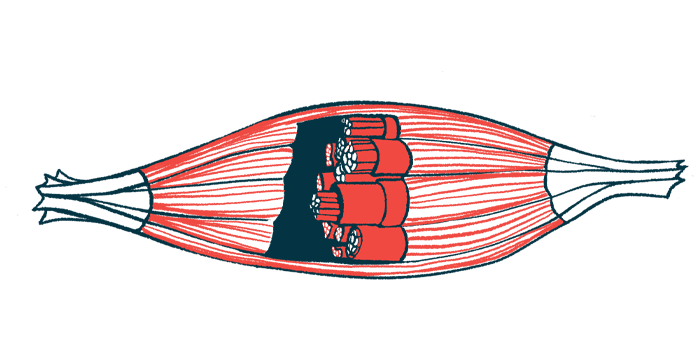AAV can lead to weak trunk muscles in very rare cases
AAV-linked muscle weakness in patients could be underestimated: Study
Written by |

In rare cases, ANCA-associated vasculitis (AAV) can result in muscle weakness that affects mainly the trunk and the muscles closest to the trunk due to blood vessel inflammation within the muscles, a study shows.
Comprehensive tests of four AAV patients with this distinct clinical feature show that muscle symptoms resemble, to some extent, those of people with inflammatory myopathy. Myopathy refers to disease affecting the muscles that control voluntary movement.
However, unlike other inflammatory muscle diseases, patients with AAV-related myopathy had normal levels of muscle damage markers, complications in other organs, and severe outcomes.
“We propose that the manifestations of our patients represent a subtype of AAV that is characterized by muscle weakness of the trunk and [regions near the trunk] as a result of vasculitis [blood vessel inflammation] within the muscles,” researchers wrote.
The study, “Antineutrophil cytoplasmic antibody-associated vasculitis with predominant truncal muscle weakness: a retrospective case series,” was published in the journal Frontiers in Neurology. The research was conducted by a team at Yamaguchi University, in Japan.
AAV typically affects several organs, including lungs and kidneys
AAV is a rare autoimmune disease in which self-reactive antibodies known as anti-neutrophil cytoplasmic autoantibodies (ANCAs) target and damage small blood vessels. The disease typically affects several organs, including the lungs and kidneys.
Muscle weakness and sensory problems are common symptoms of AAV patients with involvement of the nerves outside the brain and spinal cord, also known as peripheral nerves.
However, there have also been reports of AAV patients with weakness mainly affecting proximal muscles, of those closest to the trunk, but without sensory deficits, which suggests the muscles themselves are being affected.
However, “to our best knowledge, all of these published reports are of individual cases, and comprehensive details regarding the clinical and laboratory characteristics, response to treatment, and patient outcomes remain unknown,” the researchers wrote.
To fill this knowledge gap, the team reviewed their hospital records to identify AAV patients with weakness affecting the trunk and proximal muscles, including the upper arms, shoulders, hips, and upper legs.
Among the 21 people who underwent nerve or muscle tissue biopsy from 2017 to 2022, four patients (two men and two women, or 19%), ages 73-78, had truncal and proximal muscle weakness.
“Importantly, none of the four patients were aware of muscle weakness … although muscle weakness of the trunk muscles was obvious on examination,” the researchers wrote.
Muscle tests found no evidence of weakness in distal muscles, or those in the lower arms, hands, lower legs, and feet, “which is a typical manifestation of the mononeuritis multiplex caused by AAV,” the team wrote. Mononeuritis multiplex refers to damage to at least two separate peripheral nerve areas.
Physician awareness that AAV patients can present as weakness of the trunk muscles is essential, because this condition is accompanied by distinct complications and requires unique therapeutic strategies.
No signs of shrinkage observed in trunk and proximal muscles
No signs of shrinkage, or atrophy, were observed in the trunk and proximal muscles. While proximal muscle pain and tenderness were reported in three patients, none showed impaired sensations. Three patients showed reduced reflexes in the lower limbs.
Other affected tissues and organs varied among the patients and included the ears, lungs, kidneys, and brain, which are all typically affected by AAV, the team noted.
No signs of complications typically related to inflammatory myopathies were observed.
All patients tested positive for self-reactive ANCAs, but not for self-reactive antibodies associated with inflammatory myopathies. Blood levels of creatine kinase (CK), a marker of muscle damage, were in the normal range in all patients.
Needle electromyography, a test to measure electrical activity in muscles, revealed abnormalities in three patients. MRI showed signs of inflammation in the muscles and surrounding tissues in three patients, and muscle abnormalities were symmetrical and uniform rather than patchy.
While further tests suggested nerve damage in three of four patients, none had related symptoms, suggesting the presence of mononeuritis multiplex without symptoms.
Muscle biopsies — which were instrumental to the final diagnosis of AAV in two patients — showed death of cells in the walls of small blood vessels within the tissue surrounding muscle fibers. Inflammatory immune cells were also seen in this tissue for all four patients.
All patients received induction and maintenance AAV treatment, most commonly oral prednisolone.
Three patients showed partial improvement on muscle tests and resolution of muscle pain after induction therapy, which also included intravenous (into-the-vein) cyclophosphamide and/or methylprednisolone for three patients. Kidney disease and ear infections were also lessened in three patients.
During maintenance treatment, which may have included rituximab (sold as Rituxan in the U.S. and MabThera in Europe) and/or azathioprine, relapses were reported in two patients.
Two patients died of aspiration pneumonia, when food or liquid is breathed into the lungs and causes an infection, while on maintenance therapy.
These findings suggest “the need for prolonged maintenance therapies, even for patients with AAV presenting with muscle problems without severe involvement of other organs,” the team wrote.
The data also showed that while these patients’ muscle weakness distribution resembled those of people with inflammatory myopathies, other features were very distinct. These included “normal [blood] CK levels, the presence of ANCA, and involvement of other organs, similar to typical AAV,” the researchers wrote.
Given that none of the four patients had reported truncal muscle weakness, “muscle involvement in patients with AAV could be underestimated,” the researchers wrote.
“Physician awareness that AAV patients can present as weakness of the trunk muscles is essential, because this condition is accompanied by distinct complications and requires unique therapeutic strategies,” they added.







